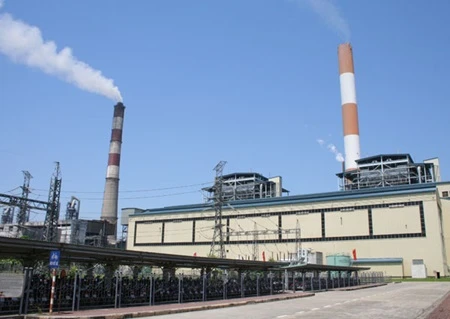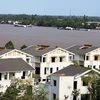 Workers of electricity company check power transmission line providing to residents of Nam Lun District, Lai Chau Province (Photo:VNA)
Workers of electricity company check power transmission line providing to residents of Nam Lun District, Lai Chau Province (Photo:VNA) Experts in pricing and economics said that they preferred pricing for power to be based on a sliding system of tariffs as at present rather than a flat rate proposed by Electricity Vietnam (EVN). At present, rates are based on six levels of consumption.
This was revealed at a conference held in Hanoi on September 22 by EVN to consider a Ministry of Trade and Industry order to seek new ways of fixing prices.
Last week, EVN announced three different ways to calculate power consumption.
The first option is to keep the current six tariff-level scheme, in which tariffs vary between 1,484 VND and 2,587 VND (6-11 cents) per kWh.
Consumers who use more than 400 kWh per month would pay nearly 2,600 VND (11 cents) for a KWh, about 1,100 VND (4 cents) more than for the first 50 kWh used.
However, this scheme is said to be too complicated and is blamed for doubling and tripling power bills of thousands households in May and June. This upset many consumers.
The second plan is to apply a flat rate to the pricing, with a suggested charge of 1,747 VND (7 cents) per kWh, which is the average of the six level electricity price in the current pricing scheme.
The third plan is to keep a level pricing mechanism, but with fewer levels.
The flat rate of 1,747 VND (7 cents) per kWh would upset consumers who use less than 240 kWh a month as they would no longer be able to enjoy the low prices of 1,484 VND and 1,533 VND (roughly 6 cents) a kWh.
Such pricing would benefit large power consumers, but cost more for 80 percent of consumers who are low-income earners and use less than 200kWh per month.
For the third proposed pricing scheme, there would be either three or four levels for electricity prices, and EVN has five different scenarios for this mechanism.
One of the five is that the first level would be 1,501 VND (6 cents) per kWh for consumption of less than 100 kWh a month, while the second and third levels would be 1,907 VND (7 cents) per kWh (less than 200 kWh a month) and 2,557 VND (10 cents) per kWh (less than 300kWh a month).
Nguyen Tien Thoa, a representative of Vietnam Development and Management Consultation Ltd Company, which EVN hired to design its new power pricing scheme, said that consumers would find it easy to calculate the sums they had to pay for power, but poor, low-income earners or small consumers would pay more than currently.
The three-or-four- tariff scheme would have minimal impacts on consumers while still encouraging them to use power economically, Thoa said. Thoa is former Head of the Pricing Management Department under the Ministry of Finance, which is in charge of proposals.
Director of the Vietnam Economics Institute, Tran Dinh Thien, said that fewer tariff schemes were better and that the first tariff should be extended to 100 or 150 kWh instead of 50 kWh as currently. Vice Chairman of National Assembly's Economic Committee, Nguyen Duc Kien, said that every option should be for the benefit of the majority. Consumers who used over 400 kWh per month account for less than five percent of total consumer number while those who use less than 100 kW are usually low-income earners.
Vice President of Electricity Association, Tran Dinh Long said that it was right to impose higher rates on this group.
EVN Deputy General Director Dinh Quang Tri said the tariff-based scheme was good as it was based on the principle "use more, pay more" and encouraged energy saving.-VNA
























